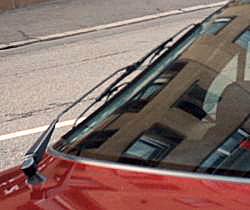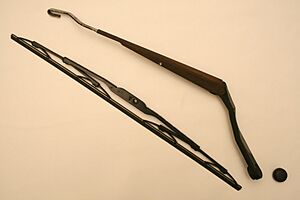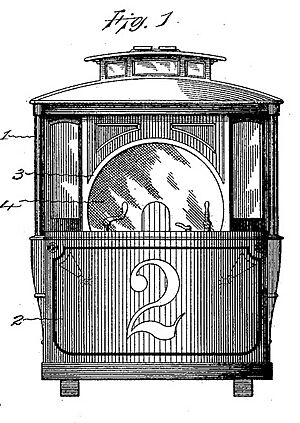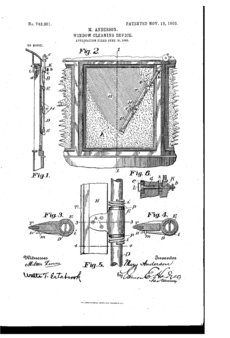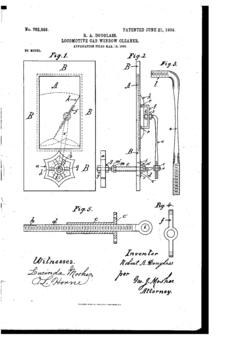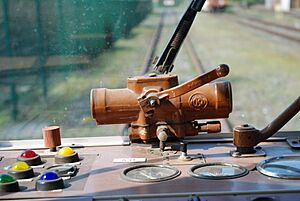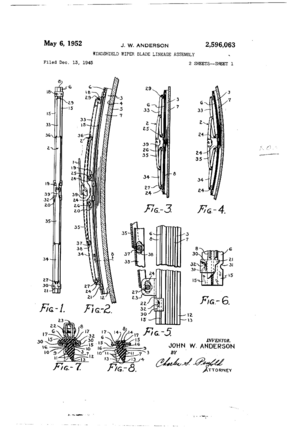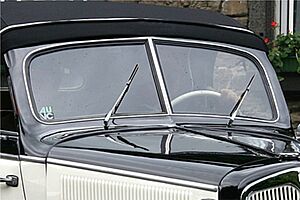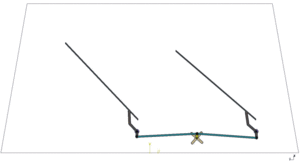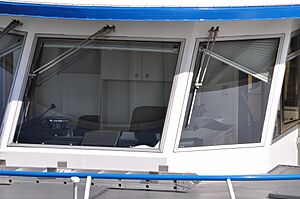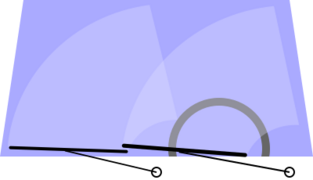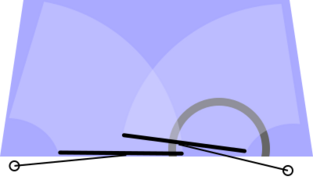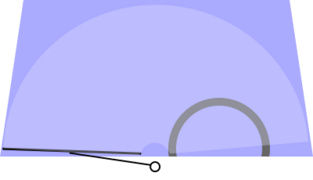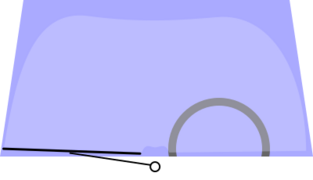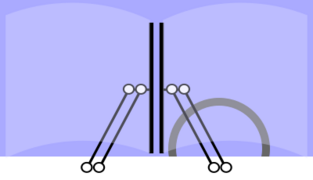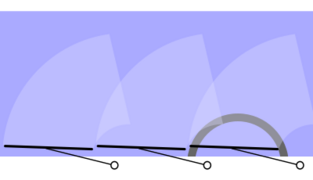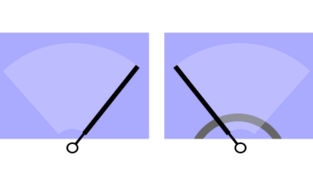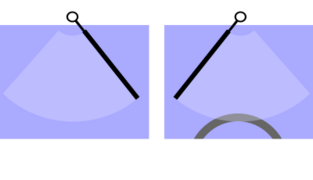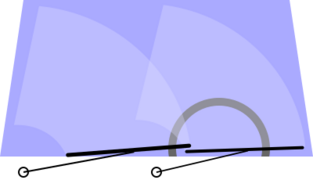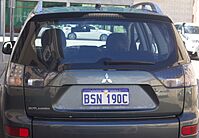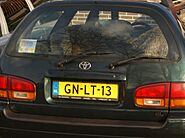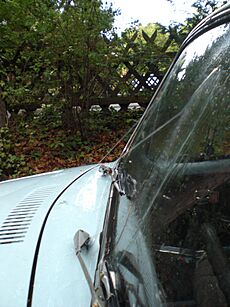Windscreen wiper facts for kids
A windscreen wiper (also called a windshield wiper in America) is a cool device that helps drivers see clearly. It removes rain, snow, ice, and dirt from a vehicle's front window. Almost all cars, trucks, buses, trains, boats, and even some airplanes have wipers. They are usually a legal requirement for safety.
A wiper has a metal arm that swings back and forth. At the end of the arm is a long rubber blade. An electric motor usually powers the arm. This motor makes the blade move across the glass, pushing away water or anything else blocking the view. Most cars have two wipers that work together. You can usually change how fast they wipe, and many have an "intermittent" setting that wipes every few seconds.
Many vehicles also have a windscreen washer system. This system sprays water or a special cleaning fluid onto the window. This helps the wipers clean off dirt or dust. In cold weather, a special fluid with antifreeze can help melt snow and ice. Some cars even have heaters for the windows or the wiper blades to keep ice from building up.
Contents
How Wipers Started
Early Ideas
One of the first ideas for a windscreen wiper was patented by George Capewell in 1896. He thought of it for fast-moving vehicles like trains. His design had two wipers that could clean the window.
Other early inventors also came up with similar ideas around 1903. These included Polish pianist Józef Hofmann and a company called Mills Munitions.
An American inventor named Mary Anderson is often given credit for creating the first working windscreen wiper in 1903. Her invention was called a "window cleaning device." It worked with a lever inside the car, much like early car wipers. She got a patent for her design in November 1903.
Another inventor, James Henry Apjohn, also patented a "window cleaning apparatus" in 1903. His design could use brushes or wipers and could be powered by a motor or by hand.
The company Trico Products, started by John R. Oishei in 1917, made one of the first wipers for cars. Today, Bosch has the world's largest wiper factory in Belgium.
The first automatic electric wiper arms were patented in 1917 by Charlotte Bridgwood. Later, William M. Folberth invented an automatic wiper that used a vacuum from the car's engine. This type of wiper was common until about 1960.
Wipers That Pause
Have you ever noticed how wipers can pause between wipes? This is called an "intermittent" wiper. Raymond Anderson first suggested an idea for this in 1923.
In 1963, Robert Kearns, an engineering professor, invented a new kind of intermittent wiper. He wanted it to work like a human eye, which blinks only every few seconds. Kearns built his system using electronics. It would pause for different amounts of time depending on how much rain was on the window.
Kearns showed his idea to the Ford Motor Company. Ford later used a similar design in their cars. Kearns sued Ford because he felt they used his idea without permission. He eventually won his case, and his story even inspired a movie called Flash of Genius.
In 1970, the French car company Citroën introduced smart rain-sensing wipers on their SM model. These wipers could sense how wet the windscreen was and adjust their pause time automatically.
How Wipers Are Powered
Most wipers today are powered by an electric motor. This motor turns a set of gears and levers that make the wiper arms move.
Some vehicles, like large trucks or buses with air brakes, use pneumatic power. This means they use pressurized air from the brake system to power a small air motor for the wipers.
Older cars sometimes used a vacuum motor. This motor got its power from the engine's vacuum. The problem was that wipers would slow down or even stop when the engine was working hard.
Some cars in the 1960s and 1970s had wipers powered by hydraulics. These used the same pump that helped with power steering.
The old Citroën 2CV car had a very unique system. Its wipers were powered by a cable connected to the car's transmission. This meant the wipers' speed changed with the car's speed! When the car stopped, the driver had to move the wipers by hand.
Wiper Blade Shapes
Early wipers had flat rubber blades. But as car designs changed and windshields became curved, these flat blades didn't work well. In 1945, John W. Anderson invented a wiper with special arms. These arms helped the blade press evenly against both curved and flat glass. This design became very popular.
Today, many wipers are "beam-type" wipers. They are made of flexible material. Wiper blades are usually made of natural rubber or a mix of rubbers. Some are even coated with graphite to help them glide smoothly.
How Wipers Move
Most car wipers are the "pivot" type. They are attached to a single arm that swings from a central point.
Modern car wipers usually move in parallel (like Fig. 1 in the gallery below). However, some cars, like certain Mercedes-Benz models, have wipers that move in opposite directions (Fig. 2). This design can clean more of the window, especially in front of the passenger. It also means the car company doesn't need to change the wiper setup for cars sold in countries where people drive on the other side of the road.
Another type is the "pantograph" wiper (Fig. 6). These are common on buses and other large vehicles with big windows. Pantograph wipers have two arms for each blade. This allows the blade to cover a much larger area. However, they often "park" in the middle of the window when not in use, which can block a small part of the driver's view.
Some cars, especially on the back window, use a simple single-blade wiper that swings from the center (Fig. 4). Mercedes-Benz also created a special "Monoblade" system (Fig. 5). This single arm extends and pulls back as it wipes, covering a large M-shaped area of the window. This way, one blade can clean a lot of the windscreen.
Other Wiper Designs
Some vehicles have unique wiper setups:
- The Alpine A310 and Panhard Dyna Z have wipers that rest at the bottom, facing outwards.
- The Simca Aronde has one wiper resting up and the other down.
- The AEC Routemaster bus uses a single pantograph wiper.
- Some trams, like the Bucharest Articulated Tramcar, also use a single pantograph wiper.
Unusual Wiper Designs

Some cars use a single, large pantograph wiper, like the Audi A2 or Toyota Yaris. This single wiper can cover a wide area.
Other vehicles, like the Renault PR100 bus or the New Routemaster bus, have wipers that are arranged upside down compared to typical designs.
Wipers on Other Parts of a Car
Rear Wipers
Many vehicles also have wipers on the back window. These are common on hatchbacks, station wagons, and sport utility vehicles. These types of vehicles often have rear windows that collect a lot of dust and dirt. Rear wipers became very popular in the 1970s.
Headlight Wipers
In the 1960s, some cars had wipers on their headlights! These were designed to keep the headlights clean for better visibility. Saab Automobile introduced them in 1970.
Today, headlight wipers are rare. Most modern cars use high-pressure fluid sprays to clean headlights instead. This is cheaper and helps with car design.
Other Cool Wiper Features
Windscreen Washer System
Most wipers work with a washer system. A pump sends a mix of water, alcohol, and soap (called windscreen washer fluid) from a tank to the windscreen. Small nozzles on the car's hood spray the fluid.
In warm places, plain water can work. But in cold places, water would freeze and damage the pump. So, special antifreeze fluid is used. The idea for a wiper and washer system together was first recorded in 1931.
Since 2012, some cars use a system called AquaBlade. This system sprays the washing liquid directly from the wiper blade itself. This helps drivers see better because there's less spray blocking their view.
Hidden Wipers
Some cars have "hidden wipers." When these wipers are turned off, they move down and out of sight, below the edge of the car's hood. This makes the car look cleaner. To lift these wipers for cleaning or changing, you often have to put them in a special "service position."
Rain-Sensing Wipers
Many modern cars have automatic wipers that can sense rain. A rain sensor detects how much rain is falling. It then automatically adjusts the wiper speed and how often they wipe. This is very convenient for drivers! You can usually still control them manually if you want.
Rain-sensing wipers first appeared on cars like the Citroën SM in the late 20th century. Today, they are an option or standard feature on many different car brands. The original system for rain-sensing wipers was invented and patented by Raymond J. Noack in 1978.
Other Ways to Clear Windows
On some ships, instead of rubber wipers, they use a "clear view screen". This is a round part of the window that spins very fast. The spinning motion throws water off, keeping that part of the window clear.
High-speed airplanes sometimes use compressed air from their engines to remove water. This saves weight and helps with aerodynamics.
Laws About Wipers
Many places have laws that say vehicles must have windscreen wipers. Wipers are often checked during car safety inspections. In some places, there's even a rule: "wipers on, lights on," meaning if you need your wipers, you should also turn on your headlights.
|


